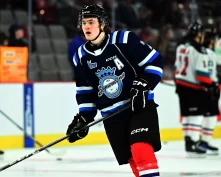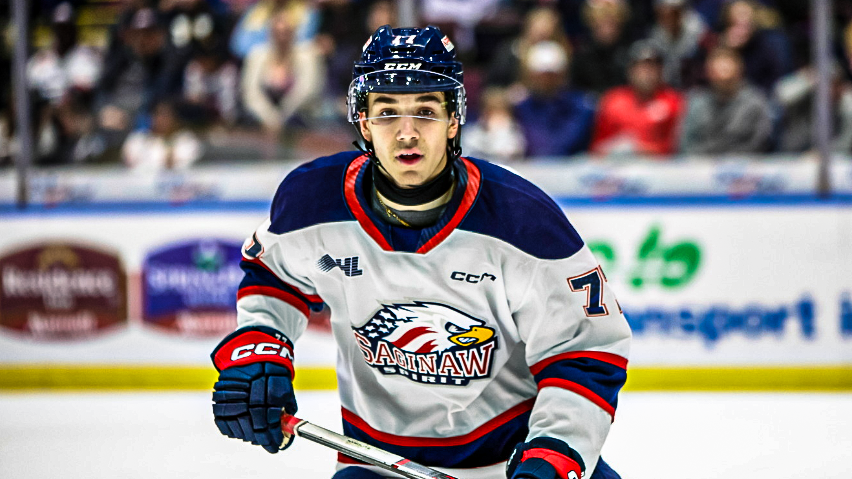QMJHL Stock Watch: Maxim Massé leading by example in Chicoutimi

The Quebec Maritimes Junior Hockey League has taken a big step forward in watchability this year.
Instead of it being a result of having a ton of drafted prospects on which NHL fans will want to keep tabs, it’s now a result of fantastic draft-eligible talent. Whether it’s the likes of Caleb Desnoyers, Émile Guité and Justin Carbonneau this year or Lars Steiner, Maddox Dagenais and Xavier Villeneuve for 2026, there are tons of first-round potential candidates in the ‘Q who are making a name for themselves this season.
However, two drafted prospects have also stood out massively so far this season — Maxim Massé has been the on-ice leader for the Chicoutimi Saguenéens, and Mathieu Cataford hasn’t missed a beat since being traded to the Rimouski Océanic. The two are making a strong push for the scoring lead in the ‘Q, and we’ll start this Stock Watch with them.
Stock Rising 📈
Maxim Massé, RW, Chicoutimi Saguenéens (Anaheim Ducks)
Despite earning the Mike Bossy trophy in his draft year last season, Maxim Massé still struggled to establish his skills and cement himself as a top-50 NHL prospect. He ended up at 54th on our board, and the Anaheim Ducks picked him up at 66th.
He had a tall task ahead of him heading into his draft-plus-one — to cement himself as a leader on a young team and take charge. And so far, that mission is looking to be a major success.
A high-end shooter with strong board-battle and net-front mechanics, Massé has fully leaned into his combination of aggression and power down low to retrieve and protect pucks, drive inside contact and push to the net. Those tools — the goal-scoring and physical mechanics — are starting to look less like by-default adaptations to his lack of pure foot speed, and more like foundational staples of his game.
With six goals and three assists in four games — and points in all of them — Massé’s offensive takeover has been immediate. But the way his strengths evolved from byproducts of his weaknesses to true core elements of what makes him special has been a treat to watch.
Mathieu Cataford, RW, Rimouski Océanic (Vegas Golden Knights)
With 11 points in four matches to start the year, Mathieu Cataford has been tearing it up so far in the QMJHL.
Having been traded from the rebuilding Halifax Mooseheads to the Rimouski Océanic after dominating the ‘Q scoreboard last year, Cataford has benefitted from playing behind a solid defensive structure to unlock the full extent of his offensive brainpower and try a ton of plays. As a result, Cataford has combined strong off-the-wall plays, near-reckless forechecking, daring play-driving attempts and sound off-puck routes to create an overwhelming toolkit for QMJHL defenders to deal with.
As he climbs the ranks, this version of Cataford — the daring, unleashed, creatively free version — might waver. Structures will get more rigid, opposing defenders more polished, and teammates more likely to provide more consistent support options. But Cataford should retain this creative freedom and find ways to incorporate it into rigid structures. That’s what would make him an above-average NHLer.
Lars Steiner, RW/C, Rouyn-Noranda Huskies (2026 NHL Draft)
Lars Steiner was by far and away the best player on an incredibly rough-to-watch Swiss team at the Hlinka-Gretzky Cup, and has now become a true play-driver as a 16-year-old ‘Q import.
The 2026 NHL Draft-eligible has accumulated a whopping 13 points in six games, good for sole position of the fourth spot in the QMJHL scoring race. What’s more, he is currently out-shining Antonin Verreault on his line, who led the entire league in scoring last year, and Bill Zonnon, who is pushing for a first-round spot in this upcoming draft.
Surprisingly intense, physical and responsible for a 5’10”, 174-pound 16-year-old playing his first ‘Q season, Steiner has shown a combination of high-end positioning and refined offensive skill to create pathways to the net both for himself and his teammates. Look-off passes, strong board interventions, timely net drives and off-puck assists make his game incredibly translatable.
It’s incredibly early, but Steiner’s 2026 NHL Draft hopes rest fairly high — these gaudy point totals aren’t a fluke. They’re a result of highly translatable skills and habits, which usually require years to develop into as consistent and refined elements as Steiner is already showing at such a young age.
Nathan Quinn, C, Québec Remparts (2025 NHL Draft)
Possibly the highest-rising stock in the ‘Q due to his starting point, Nathan Quinn headed into the 2025 NHL Draft cycle with little to no recognition. Now, he is looking like a potential first-rounder.
Incredibly intelligent and refined, Quinn has combined his physical and mental attributes to near perfection so far this season. Always active and reading plays, the Remparts’ top-line centre has earned his way into that position through his advanced processing and his ability to quickly turn takeaways into scoring chances. His chemistry with the current QMJHL scoring leader, Justin Côté, has been mesmerizing. As a result, Quinn is currently sitting on a tally of nine points in seven games played.
Strong in the faceoff dot, positionally sound in all three zones and sporting a constant supporting mindset, Quinn has all the makings of an Owen Beck type — minus the feet, but with more offensive pop at the same age. His playmaking is a truly refined attribute, his shot has NHL average written all over it, and he mans the net front with timely and precise execution. If the feet and handling skill can improve even somewhat, Quinn has all the rest.
Stock Steady ↔️
Maddox Dagenais, C, Québec Remparts (2026 NHL Draft)
There is so much hype surrounding Maddox Dagenais in Québec hockey circles. The prevailing opinion among those who push and promote Québec-born talent is that Dagenais has the highest upside since Alexis Lafrenière, and might even exceed him in that regard.
So far this year, Dagenais has delivered on those expectations — but he hasn’t yet exceeded them.
In seven games, Dagenais has amassed six goals and five assists for 11 points, and has looked the part of a game-breaker. He has a ridiculous release, he can open the game laterally with strong East-West and scissor plays, and he can dangle with the best of them — all in a 6’3”, 180-pound frame. There are some confusing decisions in his game, however, which keep him from being the true complete centre he could be. Defensive lapses and a tendency to play despite structure instead of within it make him a difficult player for his coaches to trust.
As of right now, he’s a 16-year-old who is still figuring out how to go from dominating through skill to dominating through details, and that’s not unusual for a phenom with so much to work with skill-wise. As he grows and develops, his coaches will likely teach those concepts into his game. These things usually work themselves out with time, and if they do in Dagenais’ case, there’s a strong chance he ends up being a top-three pick in 2026.
Justin Carbonneau, RW, Blainville-Boisbriand Armada (2025 NHL Draft)
With 12 points in six games so far, his stats alone would indicate that Justin Carbonneau should be in the risers list above. However, some areas of concern have kept him from rocketing up draft boards.
To start with the positives, Carbonneau has so many tools to work with. A high-pace attacker with strong skating, good size, a bomb of a shot, dynamic handling and flashes of passing skill, Carbonneau tries everything in-stride. It has made his full-time graduation to the top line in Blainville-Boisbriand on the wing of Jonathan Fauchon seamless — Fauchon makes the reads, Carbonneau makes the plays.
On the downside, however, Carbonneau can be incredibly frustrating to watch. His handling decisions especially are what hold him back from being a proper dynamic force. He forces one-on-one plays instead of using give-and-gos to get past a layer of pressure, he drives head-first at structures instead of picking them apart, and even though the moves are executed as well as they can be, his choice of moves can be perplexing. Off the puck, that issue arises as well, perhaps to a lesser extent.
There are flashes of smarts in his playmaking, however — look-offs, angle changes and full-speed area passes feature sporadically in his arsenal. Despite that, the strength of Carbonneau’s foundation of size, speed and shooting skill lends itself to a creative goal-scorer projection. The rest could improve, but those elements will likely remain at the core of his skillset, and more importantly, make him a first-rounder despite the warts.
Stock Falling 📉
Alex Huang, D, Chicoutimi Saguenéens (2025 NHL Draft)
Alex Huang’s Hlinka-Gretzky Cup tournament for Canada offered a ton of promise heading into his draft year. The things that make him tick — his high-end skating, his transition playmaking game and his shooting threat from the point — remained staples of his skillset. More importantly, though, Huang turned his biggest weakness in his rush defending reads into a strength while sharing the blue line with Matthew Schaefer, and even showed some physical chops in flashes. These elements combined to give him legitimate top-25 hopes for our preliminary board.
However, since returning to Chicoutimi, there just hasn’t been enough there to make Huang a first-rounder. For lack of a better word, he has been ordinary. He hasn’t been particularly creative or manipulative offensively, and although he has definitely been better defensively than he was last year, it hasn’t been enough to move the needle.
At its core, the issue is Huang’s over-reliance on his separating tool — his skating. He gets moving and then figures out what his skating results in, rather than planning and orchestrating attacks. A bit more meticulousness in his approach would go a long way in allowing him to showcase his handling and passing skill, and would place him back in first-round territory.
Carlos Händel, D, Halifax Mooseheads (2025 NHL Draft)
At the Hlinka-Gretzky Cup, Carlos Händel was arguably Germany’s best player. Calm, creative, active offensively and suffocating with his defensive stickwork, the 6’1” right-shot blue-liner impressed massively and showed flashes of first-round talent. His move to Halifax after the Mooseheads used a first-rounder in the CHL Import Draft to acquire his rights was interesting as well, given that he had been developing in Malmö’s junior system to that point.
The transition, unfortunately for him, has been rough.
Händel just hasn’t been able to handle the hard, almost reckless forechecking that the QMJHL has to offer. Used to having more time than he does now, the blue-liner has been getting trapped below his goal-line frequently. Furthermore, the issue that raised questions even at the Hlinka — his lack of intensity — has only been exacerbated with the hard North-South sequences he has been facing so far.
The young defender still has time to adapt — but that adaptation will make or break his projection. If he can, it’ll not only be a step in the right direction for his current performances, but will also indicate Händel’s overall ability to overcome changes in style and hint at that adaptability continuing as he turns pro. If he can’t, there isn’t much of a world in which he gets picked in the top three rounds.



